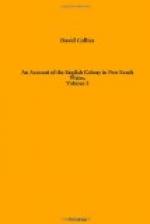The Martha schooner, having some time back sailed again to the southward, returned on the 6th with a cargo of oil and seal skins. The Nautilus having left some of her people upon Cape Barren Island, it appeared by their accounts, that the most productive time for the seals among those islands was from November to May. They stated, that they had much fine weather during the winter months, and met with very little frost or severe cold. Cape Barren is in 40 degrees 26 minutes 20 seconds S latitude.
About this time many of the Irish prisoners lately arrived were afflicted with dysenteric complaints, of which several died.
Much has been said of the little indulgence to which some of the settlers were, from their own misconduct, entitled. An instance of misbehaviour occurred in a description of these people from whom it could scarcely have been expected. The settlers who were fixed on the banks of George’s river had formerly served in the marine detachment, and afterwards in the New South Wales corps. By their entreaties having prevailed upon the governor to supply them with some live stock, they were furnished each with a ewe sheep, of which they were no sooner possessed than they sold them. This coming to the governor’s knowledge, he directed them to be seized, and instantly returned into the flock belonging to government. Such conduct on their part certainly precluded them from ever soliciting similar assistance again.
Accounts of a most alarming nature were received toward the latter end of the month from George’s river and the Hawkesbury. The weather had, unfortunately for the maize now ripe, been uncommonly bad for three weeks, the wind blowing a heavy gale, accompanied with torrents of rain that very soon swelled the river Hawkesbury, and the creeks in George’s river, beyond their banks; laying all the adjacent flat country, with the corn on it, under water. Much damage, of course, followed the desolation which this ill-timed flood spread over the cultivated grounds; and, although fewer than could have been expected, some lives were lost.
The prospect of an abundant maize harvest was wholly destroyed, and every other work was suspended for a while, to prepare the ground a second time this season for wheat. The settlement was yet too young to be able to withstand such a succession of ill-fortune without its being felt, in some degree, an inconvenience and expense to the mother country. Had the settlers themselves in general been of a more industrious turn, they would have been better prepared for such accidents; and it was much to be lamented, that, in establishing them on the banks of the Hawkesbury, they had not with more attention considered the manifest signs of the floods to which the river appeared to the first discoverers to be liable, and erected their dwellings upon the higher grounds; or that the inundations which had lately happened had not occurred at an earlier period, when there were but few settlers. These indeed had been such as formerly no one had any conception of, and exceeded in horror and destruction any thing that could have been imagined.




